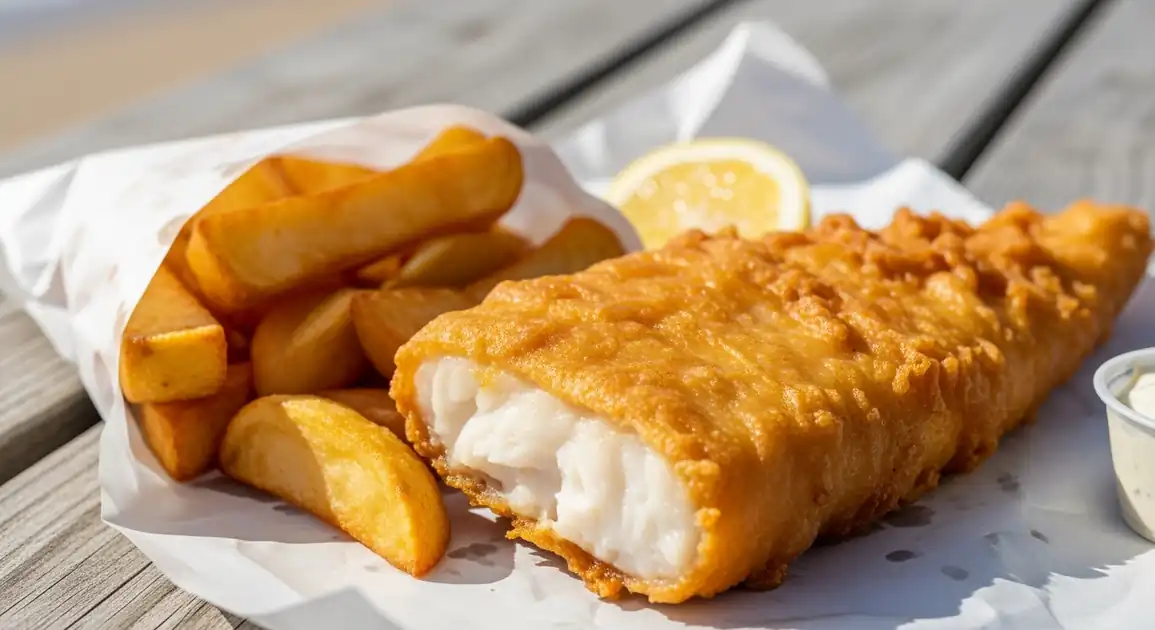Fish and Chips
Fish and Chips

Description
Fish and chips are a national institution in New Zealand, available in nearly every town and city. Quality can vary, but dedicated local fish and chip shops ('chippies') are ubiquitous, particularly popular for Friday night takeaways and summer meals near the coast. Freshness of local fish species is a key selling point.
Dietary Information
Serving information
Serving style
Almost always served wrapped in white butcher's paper, sometimes with a layer of newspaper outside (less common now for food safety reasons). Eaten casually, often straight from the paper, usually with hands. Lemon wedges and small tubs of tartare sauce or tomato sauce are common extras.
Quick facts
Typically open for lunch (approx. 11 AM / 12 PM - 2 PM) and dinner (approx. 4:30 PM / 5 PM - 8 PM / 9 PM). Some may close between lunch and dinner service. Hours often extend later on Friday/Saturday.
Safety Tips
What to Look For
-
Fish cooked fresh to order
Ensures the fish is hot, crispy, and hasn't been sitting, reducing bacterial risk and maintaining quality.
-
Hot, clean-looking cooking oil
Oil should be hot enough to cook quickly and seal the food. Avoid shops using very dark, dirty, or smoking oil which affects taste and safety.
-
Clean premises and food handling
A tidy shop with staff practicing good hygiene (using tongs, clean surfaces) is a positive sign.
-
Crispy, golden batter/crumbing
Indicates proper cooking temperature and technique. Avoid soggy or pale-looking fish.
-
Busy shop with high turnover
Suggests ingredients are likely fresh due to frequent restocking.
What to avoid
-
Pre-cooked fish sitting under heat lamps
Fish quality degrades quickly, becoming dry or soggy, and holding food at warm temperatures increases risk.
-
Excessively greasy product
Can indicate oil wasn't hot enough or the food wasn't drained properly. Ask for it to be well-drained.
-
Shop with visibly dirty counters, floors, or equipment
Poor general cleanliness can indicate broader hygiene issues.
-
Fish or chips that look undercooked or burnt
Improper cooking can affect both taste and safety (undercooked) or introduce burnt flavours.
Price information
Price range
Budget tips
- Hoki or Tarakihi are usually the most budget-friendly fish options.
- Ordering 'minimum chips' (usually $4-7) is often enough for two people.
- Look for lunch specials or family packs for better value.
- Local suburban shops are often cheaper than tourist hotspots.
Value indicators
- Generous portion size for fish and chips.
- Fish cooked perfectly - flaky inside, crispy outside.
- Use of fresh, high-quality local fish.
- Chips are thick-cut, fluffy inside, and crispy.
- Option of different fish types clearly displayed.
Where to Find This Dish
Coastal Towns/Beaches
Nearly every beach town has at least one popular fish and chip shop.
Main street of coastal towns, Near surf clubs, Waterfront areas
Lunchtime, Evening (especially summer)
Suburban Shopping Strips
Local 'chippies' are staples in neighbourhood shopping areas.
Local dairies (convenience stores), Small shopping centres
Evening
City Centres/Food Courts
Some options available, though potentially more expensive or part of larger takeaway outlets.
Food courts, Central city takeaway lanes
Lunchtime, Evening
Vendor Tips
- Ask what fish is freshest or recommended that day.
- Specify salt/vinegar preference clearly.
- Check if they offer 'chicken salt' if you prefer it.
- Be prepared to wait, especially during peak hours, as good places cook to order.
How to Order
Regional Variations
-
Battered Fish
(Battered Fish)
Fish coated in a liquid batter before frying, resulting in a thicker, puffier crust.
-
Crumbed Fish
(Crumbed Fish)
Fish coated in breadcrumbs before frying, yielding a thinner, often crunchier crust.
-
Specific Fish Types (Snapper, Hoki, etc.)
(Snapper, Hoki, Tarakihi, Gurnard)
Shops usually offer several types of fish, differing in price, flavour, and texture.
-
Kumara Chips
(Kumara Chips)
Chips made from Kumara (New Zealand sweet potato) instead of regular potato, offering a sweeter flavour.
-
Potato Fritter
(Potato Fritter)
A slice of potato, battered and deep-fried.
-
Hot Dog / Battered Sausage
(Hot Dog / Battered Sausage)
A saveloy or sausage, battered and deep-fried. A 'hot dog' in this context is not in a bun.
-
Pineapple Fritter
(Pineapple Fritter)
A ring of pineapple, battered and deep-fried. Sweet and savoury.
-
Mussels / Oysters
(Mussels / Oysters)
Fresh mussels or oysters, battered and deep-fried, especially common in coastal areas.
Cultural context
History
Originating in the UK, fish and chips were brought to New Zealand by British settlers and quickly became a cheap, accessible, and popular meal, particularly for the working class. Its popularity soared through the 20th century, becoming synonymous with casual Friday night dinners, summer holidays, and eating by the beach. Local fish species and preferences shaped the distinct Kiwi style of fish and chips.
Local significance
An iconic Kiwi food experience, representing casual comfort food and often associated with family time, holidays, and the beach lifestyle.
Eating customs
- Usually eaten with hands, straight from the paper wrapping.
- Adding your own tomato sauce ('watties sauce') is common.
- Best enjoyed outdoors or very casually at home.